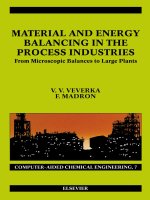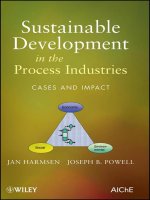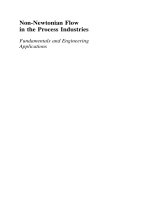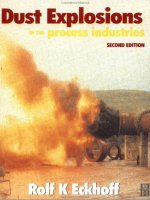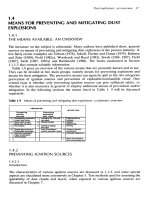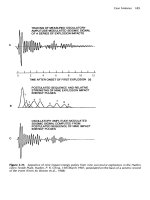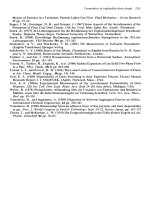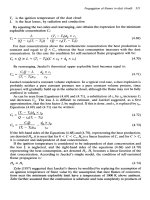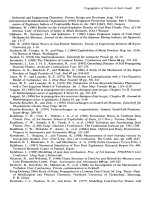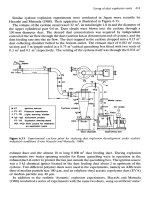Dust Explosions in the Process Industries Second Edition phần 1 doc
Bạn đang xem bản rút gọn của tài liệu. Xem và tải ngay bản đầy đủ của tài liệu tại đây (3.31 MB, 66 trang )
Dust Explosions
in the Process Industries
Second Edition
Rolf
K.
Eckhoff
1
EINEMANN
Butterworth-Heinemann
Linacre House, Jordan Hill, Oxford
OX2
8DP
225
Wildwood Avenue, Woburn,
MA
01801-2041
A
division
of
the Reed Educational
and
Professional Publishing Ltd
@A member of the Reed Elsevier plc group
OX
t
0
K
I)
10H
A
N
N
ES
H
IJ
KG
A
I!C
K
LAN
I1
BOS-ION
M
EL
BOU
R
NE
N
E
W
I1
EL
Ii
I
First
published
1991
Paperback edition 1994
Second edition
1997
Reprinted 1998, 1999
('
Reed Educational
and
Professional Publishing Ltd
1991,
1997
All rights reserved.
No
part
of
this publication
may be reproduced in any material form (including
photocopying or storing in any medium by electronic
means and whether or not transiently or incidentally
to
some other use of this publication) without the
written permission of the copyright holder except in
accordance with the provisions
of
the Copyright.
Designs and Patents Act
1988
or
under the terms of a
licence issued by the Copyright Licensing Agency Ltd,
YO
Tottenham Court Road, London, England
WIP
YHE.
Applications for the copyright holder's written permission
to
reproduce any part of this publication should be addressed
to
the publishers
British Library Cataloguing in Publication Data
A catalogue record for this book is available
from the British Library
Library
of
Congress Cataloguing in Publication Data
A catalogue record for this
book
is available
from the Library of Congress
ISBN
0
7506
3270
4
Typeset by Keyword Ltd, Wallington, Surrey
Printed in Great Britain by
St
Edmundsbury Press Ltd, Bury St Edmunds,
Suffolk
With deep gratitude for their love and support,
1
dedicate this
book
to my wife Astrid and
our children Kristian, Ragnar, Solveig and Jorunn, and
to
my mother and the memory
of
my father. The words
in
Isaiah
42.16
also gave me hope and courage.
Contents
Foreword
Preface
viii
ix
1
Dust explosions
-
origin, propagation, prevention, and mitigation: an
overview
1.1
The nature of dust explosions
1.2 Significance of the dust explosion hazard: statistical records
1.3 Dust and dust cloud properties that influence ignitability and explosion
violence
1.4 Means for preventing and mitigating dust explosions
1.5 Selecting appropriate means for preventing and mitigating dust
explosions
2 Case histories
2.1 Introduction
2.2 The explosion in a flour warehouse in Turin on 14th December, 1785
2.3 Grain dust explosions in Norway
2.4 Four grain dust explosions in
USA,
1980-1981
2.5
A
dust explosion in a fish meal factory in Norway in 1975
2.6 Smouldering gas explosion in a silo plant in Stavanger, Norway, in
November 1985
2.7 Smouldering gas explosions in a large storage facility for grain and
feedstuffs in Tomylovo in the Knibyshev Region of USSR
2.8 Smouldering gas explosion and subsequent successful extinction of
smouldering combustion in pelletized wheat bran in a silo cell at Nord
Mills, Malmo, Sweden, in 1989
2.9 Linen flax dust explosion in Harbin linen textile plant,
P.
R. China,
March 1987
2.10 Fires and explosions in coal dust plants
2.11 Dust explosion in a silicon powder grinding plant at Bremanger,
2.12 Two devastating aluminium dust explosions
Norway, in 1972
3
Generation
of
explosible dust clouds by re-entrainment and re-dispersion
of
deposited dust in air
3.1 Background
1
1
20
25
57
123
159
159
159
162
169
175
180
181
183
187
190
193
195
203
203
vi
Contents
3.2 Structure of problem
3.3 Attraction forces between particles in powder
or
dust deposits
3.4 Relationship between inter-particle attraction forces and strength of bulk
powder
3.5 Dynamics of particles suspended in a gas
3.6 Dislodgement of dust particles from a dust or powder deposit by
interaction with an airflow
3.7 Dispersion
of
agglomerates of cohesive particles suspended in a gas, by
flow through a narrow nozzle
3.8 Diffusion
of
dust particles in a turbulent gas flow
3.9 Methods for generating experimental dust clouds for dust explosion
research purposes
4 Propagation of flames in dust clouds
4.1
4.2 Laminar dust flames
4.3
4.4 Turbulent flame propagation
4.5
Ignition and combustion of single particles
Non-laminar dust flame propagation phenomena in vertical ducts
Detonations in dust clouds in air
5
Ignition of dust clouds and dust deposits: further consideration of some
selected aspects
5.1 What is ignition?
5.2 Self-heating and self-ignition
in
powder deposits
5.3 Ignition of dust clouds by electric spark discharges between two
metal electrodes
5.4 Ignition of dust clouds by heat from mechanical rubbing, grinding
or
impact between solid bodies
5.5 Ignition of dust clouds by hot surfaces
6
Sizing of dust explosion vents in the process industries: further
consideration of some important aspects
6.1 Some vent sizing methods used in Europe and
USA
6.2 Comparison of data from recent realistic full-scale vented dust explosion
experiments, with predictions by various vent sizing methods
6.3 Vent sizing procedures for the present and near future
6.4 Influence of actual turbulence intensity of the burning dust cloud
on
the
maximum pressure in a vented dust explosion
6.5 Theories of dust explosion venting
6.6 Probabilistic nature of the practical vent sizing problem
7
Assessment
of
ignitability, explosibility and related properties of dusts by
laboratory scale tests
7.1 Historical background
7.2
7.3
A philosophy of testing ignitability and explosibility of dusts:
relationship between test results and the real industrial hazard
Sampling of dusts for testing
204
206
21 1
217
226
236
239
244
256
256
27
1
325
332
375
392
392
395
41
1
426
430
439
439
443
46
1
465
467
474
48
1
481
483
485
Contents
vii
7.4 Measurement of physical characteristics of dusts related to their
ignitability and explosibility
7.5 Can clouds of the dust give explosions at all? Yes/No screening tests
7.6 Can hazardous quantities of explosible gases evolve from the dust during
heating?
7.7 Ignition
of
dust deposits/layers
7.8 Minimum ignition temperature
of
dust clouds
7.9 Minimum electric spark ignition energy of dust layers
7.10 Minimum electric spark ignition energy of dust clouds
7.11 Sensitivity of dust layers to mechanical impact and friction
7.12 Sensitivity of dust clouds to ignition by metal sparkdhot spots or
7.13 Minimum explosible dust concentration
7.14 Maximum explosion pressure at constant volume
7.15 Maximum rate of rise of explosion pressure at constant volume
7.16 Efficacy of explosion suppression systems
7.17 Maximum explosion pressure and explosion violence
of
hybrid mixtures
7.18 Tests of dust clouds at initial pressures and temperatures other than
7.19 Influence of oxygen content in oxidizing gas on the ignitability and
7.20 Influence of adding inert dust to the combustible dust,
on
the ignitability
7.21 Hazard classification of explosible dusts
thermite flashes from accidental mechanical impact
(explosion violence)
of dust and gas in air
normal atmospheric conditions
explosibility of dust clouds
and explosibility of dust clouds
8.1
8.2
8.3
8.4
8.5
8.6
8.7
8.8
8.9
8
Research and development 1990-96
lntroduction
Status and outstanding problems
in
fundamental research related
to
dust
explosions
Status and outstanding problems
in
preventing and mitigating/controlling
dust explosions
in
industrial practice
Status and outstanding problems
in
testing of dust ignitability and
explosibility
Expert
systems
-
friends or enemies
The human hazard factors
Joint rcscarch efforts in Europe. research and development in
P.
R.
China
Conclusion
A
c
k
n
o
w
I
edge me
n
t
Appendix: Ignitability and explosibility data
for
dust from laboratory tests
A1 Tables Al, A2 and A3, and comments, from
BIA
(1987)
A2 Applicability of earlier USBM test data
Index
487
496
499
501
507
513
517
522
524
527
534
543
546
548
549
550
552
553
559
559
56
I
573
5x2
586
5x7
587
588
588
602
602
630
635
Foreword
Experience has shown all too clearly that ignition and explosion can occur wherever
combustible dusts are handled or permitted to accumulate as a by-product
of
related
activities. Despite reasonable precautions, accidents can and do happen; recognition
of
this universal hazard and the potential means for its control is widespread, as evidenced
by
the many individuals and groups worldwide performing research and developing codes
and regulations.
The primary means
of
controlling and minimizing this recognized hazard are study,
regulation and education; to accomplish this, specific knowledge must be generated and
disseminated for the benefit
of
all
interested people. Rolf Eckhoff has, in my estimation,
prepared an outstanding book. It presents a detailed and comprehensive critique
of
all the
significant phases relating to the hazard and control
of
a dust explosion, and offers an up
to date evaluation
of
prevalent activities, testing methods, design measures and safe
operating tcchniques.
The author is in an outstanding position to write this text, having spent
a
lifetime in
research on dust and gas explosions. He assimilates information from worldwide contacts
whilst retaining his independence
of
thought and the ability to see clearly through
problems. His clear and concise language and thorough approach will benefit his fellow
workers and all who read his book. His presentation
of
the mathematics. tables and figures
is clear and striking. The inclusion
of
a comprehensive bibliography indicates not only his
own thoroughness, but also the widespread nature
of
research into dust explosions
throughout the world.
To
my knowledge this book is the most complete compilation to date
of
the state
of
the
art
on
industrial dust explosions.
John Nagy, Finleyville, PA, USA
(Formerly
of
the US Bureau
of
Mines)
Preface
to
first edition
The ambitious objective of this book is to provide an overview of the present state of the
art. However, the amount of published information on dust explosions worldwide is vast,
at the same time as much additional work was never printed in retrievable literature.
Whilst
I
feel that I may have been able to cover some of the English/American and
German open literature fairly well, most of the valuable research published in other
languages has had to be left out simply because of the language barrier. Future attempts
at summarizing some of this work in English should indeed be encouraged.
Although I have tried to give a reasonably balanced account, the book also reflects my
personal research background. For example, other authors might perhaps not have
included a separate chapter
on
the mechanics of dust deposits and dust particles.
However, to me the important role of powder mechanics in dust explosions is evident.
The book perhaps also reflects that most of my dust explosion research has been related to
ignition, venting and testing.
The confrontation with the early research carried out by the pioneers in the UK,
Germany, USA and other countries creates deep humility and admiration for the out-
standing work performed by these people. Lack of sophisticated diagnostics did not pre-
vent them from penetrating the logical structure of the problem and to draw long-lasting
conclusions from their observations. It is a pity that much of this work seems to be
neglected in more recent research. Too often mankind reinvents the wheel
-
this also
applies to dust explosion research.
I would like to use this opportunity to thank Professor Emeritus
H
E
Rose, Dr.S., for
bringing the existence of the phenomenon of dust explosions to my attention for the first
time, and for giving me the opportunity to become acquainted with the subject, during my
two years of study at King’s College, London,
1966-68.
Many thanks also to Alv Astad and Helge Aas for their encouragement and active
participation when dust explosion research, sponsored by Norwegian industry, was
initiated at Chr. Michelsen Institute, Bergen, Norway, about 1970.
The Royal Norwegian Council for Scientific and Industrial Research (NTNF) has given
valuable financial support to
CMI’s
dust (and gas) explosion research from
1972
until
today, and also allocated a generous special grant for the writing of this book. An addi-
tional valuable grant for the work with the book was given by the Swedish Fire Research
Board (Brandforsk).
I
am also deeply grateful to all the industrial companies, research institutions and
colleagues in many countries, who made available to me and allowed me to make use of
their photographs and other illustrations. A special thanks to
Berufsgenossenschaftliches
Institut fur Arbeitssicherheit (BIA) in Germany for permission to translate and publish the
tables in the Appendix.
I also wish to express my gratitude to those who have kindly read through sections
of the draft manuscript and/or given constructive criticism and advice. John Nagy,
Derek Bradley, Geoffrey
Lunn,
Bjmn Hjertager, Gisle Enstad, Dag Bjerketvedt, Ivar
0.
Sand and Claus Donat should be mentioned specifically. Also my indebtedness goes to
Chr. Michelsen Institute, which in its spirit of intellectual freedom coupled to responsi-
bility, gave me the opportunity to establish dust and gas explosion research as an explicit
x
Preface
activity of the institute. The institute also gave high priority to and allocated resources for
the writing of this book, for which I am also most grateful.
This short preface does not allow me to mention the names of all the good people with
whom I have had the privilege to work during my
20
years of dust and gas explosion
research at CMI, and who deserve my sincere thanks. However, there is one exception
-
Kjell Fuhre, who worked with me from 1970 to 1988. I wish to thank him for having
devoted his exceptional engineering talent to our experimental dust and gas explosion
research, in laboratory scale as well as in full-size industrial equipment.
I wish to express a special thanks to Aaslaug Mikalsen, who, aided by more than
20
years of experience in interpreting my handwriting, was able to transform the untidy
handwritten manuscript to a most presentable format on CMI’s word processing system.
Many thanks also to Per-Gunnar Lunde for having traced the majority of the drawings in
the book.
Rolf K. Eckhoff
Preface
to
second edition
The present book was first published in August 1991 as a hard cover version, which was
out of print by spring 1994. The publisher then decided to produce a new paperback
version, which was essentially the original book with some minor adjustments. This second
version was out of print by mid 1996.
In 1992 I was asked to give a review lecture on the state-of-the-art on research on dust
explosion prevention and mitigation, at an international summer school. This gave me an
excellent opportunity to pick up again from where I had to stop the review of the literature
in 1990 to be able to submit the original book manuscript to the publishers by their
deadline. The summer school was repeated both in 1993 and 1994, which encouraged
me to update the review accordingly. It gradually became clear to me that the review
would only need to be modified slightly to form a useful new Chapter
8
of my book. The
publisher agreed to this idea, and decided that such a chapter, covering material published
after 1990, be included in the new edition of the book to appear in 1996/1997.
I
therefore
continued to incorporate new material right up to the deadline for submission of the final
manuscript in May 1996.
After having worked for more than 30 years at CMR (previously CMI) in contract
research and consultancy for industry, I started, from 1996, a new, challenging career as a
full time professor of process safety technology at the University of Bergen. It is my hope
that my students will find the present book, with the new Chapter 8, a helpful guide into
one of the important facets of process safety.
Rolf K. Eckhoff
Chapter
I
Dust explosions
-
origin, propagation,
prevention and mitigation: an overview
1.1
THE NATURE
OF
DUST EXPLOSIONS
1.1.1
THE PHENOMENON
1.1.1.1
What
is
an explosion?
The concept of
explosion
is not unambiguous. Various encyclopediae give varying
definitions that mainly fall in two categories. The first focuses on the noise
or
‘bang’ due to
the sudden release of a strong pressure wave, or blast wave. The origin of this pressure
wave, whether a chemical
or
mechanical energy release, is of secondary concern. This
definition of an explosion is in accordance with the basic meaning of the word (‘sudden
outburst’).
The second category
of
definitions is confined to explosions caused by sudden releases
of chemical energy. This includes explosions of gases and dusts and solid explosives. The
emphasis
is
then often put on the chemical energy release itself, and explosion is defined
accordingly. One possible definition could then be ‘An explosion is an exothermal
chemical process that, when occurring at constant volume, gives rise to a sudden and
significant pressure rise’.
In the present text the definition of an explosion will shift pragmatically between the
two alternatives, focusing at either cause or effect, depending on the context.
1.1.1.2
What
is
a
dust explosion?
The phenomenon named
dust
explosions
is in fact quite simple and easy to envisage in
terms of daily life experience. Any solid material that can bum in air will do
so
with a
violence and speed that increases with increasing degree of sub-division of the material.
Figure l.l(a) illustrates how a piece of wood, once ignited, burns slowly, releasing its heat
over a long period
of
time. When cut in small pieces, as illustrated in Figure l.l(b), the
combustion rate increases because the total contact surface area between wood and air has
been increased. Also, the ignition of the wood has become easier. If the sub-division is
continued right down to the level of small particles
of
sizes of the order of
0.1
mm
or
less,
and the particles are suspended in a sufficiently large volume of air to give each particle
enough space for its unrestricted burning, the combustion rate will be very fast, and the
energy required for ignition very small. Such a burning dust cloud is a dust explosion. In
2
Dust Explosions in the Process industries
la1
SLOW
COMBUSTION
(b)
FAST COMBUSTION
IC)
EXPLOSION
Figure
1.1
increasing sub-division
lllustration ofhow the combustion rate
of
a
given mass ofcombustible solid increases with
general, the dust cloud will be easier to ignite and burn more violently the smaller the dust
particles are, down to some limiting particle size that depends on the type of dust material.
If
such an explosive combustion of a dust cloud takes place inside process equipment or
work rooms, the pressure in the fully or partly enclosed explosion space may rise rapidly
and the process equipment or building may burst, and life, limb and property can be lost.
1.1.1.3
Specific surface area
-
a
convenient measure
of
dust fineness
The degree of subdivision of the solid can be expressed either in terms of a characteristic
particle size, or as the total surface area per unit volume
or
unit mass of the solid. The
latter characteristic is called the specific surface area of the subdivided solid.
Figure 1.2 illustrates the relationship between the particle size and the specific surface
area. After sub-division of the original cube to the left into eight cubes of half the linear
dimension of the original cube, the total surface area has increased by a factor of two,
which indicates that the specific surface area is simply proportional to the reciprocal of the
linear dimension of the cube. This can be confirmed by simply expressing the specific
surface area
S
as the ratio between surface area and volume of one single cube of edge
length
x.
One then finds
6x2
6
s= =-
x3
x
This is also the specific surface area of a powder or dust consisting of monosized cubes
of
edge length
x.
(1.1)
The same result applies to spheres of diameter
x,
because
6
(7r/6)
x
x3
x
(1.2)
-
Xi2
S=
For flake-shaped particles for which the thickness
x
is much smaller than the
characteristic flake diameter, one has
2
s=-
(1.3)
X
Dust
explosions: an overview
3
Figure
1.2
sub-division (From Hammond and Kaye,
1963)
Illustration of the increase
of
the specific surface area of a solid with increasing
If
a spherical particle
of
diameter, for example,
5
pm is compressed and deformed
plastically to a thin flake of thickness, for example,
0.2
pm (flake diameter about
20
pm),
Equations
(1.2)
and (1.3) show that the specific surface area increases by a factor of 8.3.
This effect is utilized when producing highly reactive aluminium flakes from atomized
(spherical) aluminium particles (see Section 1.3.2).
If the ‘particles’ are fibres of large length-to-diameter ratio, and the diameter is
x,
one
gets
4
s=-
(1.4)
X
Fibrous dusts may either be natural, for example cellulose, or synthetic, such as flock
materials. Ignitability and explosibility of synthetic flock materials were discussed by
Schenk
(1984).
In the case of polysized cubes or spheres, the specific surface area equals
S
=
62x!nj
/
Cx?n,
(1.5)
where
nj
is the number of particles in the size interval
i
in the sample considered.
As
the particles get smaller, the inter-particle forces play an increasingly important role
compared with gravity forces and in a given practical situation the dust in a dust cloud may
not necessarily be dispersed into the small individual primary particles, but rather into
larger agglomerates,
or
lumps. The effective particle size will therefore be larger and the
effective specific surface area smaller than if the primary particles had been completely
dispersed. This important aspect is discussed in Section 1.3.3 and in depth in Chapter 3.
See also Section 7.4.2.
1.1.1.4
Factors influencing ignition sensitivity
and
explosion violence
of
dust
clouds
Particle size/specific surface area of the dust is a central factor. However, there are other
important factors too, and the comprehensive list may look as follows:
1.
Chemical composition of the dust, including its moisture content.
2.
Chemical composition, and initial pressure and temperature of the gas phase.
4
Dust
Explosions
in
the
Process Industries
3.
Distributions of particle sizes and shapes in the dust, determining the specific surface
area of the dust in the fully dispersed state.
4.
Degree of dispersion, or agglomeration,
of
dust particles, determining the effective
specific surface area available to the combustion process in the dust cloud in the actual
industrial situation.
5.
Distribution of dust concentration in the actual cloud.
6.
Distribution of initial turbulence in the actual cloud.
7.
Possibility of generation
of
explosion-induced turbulence in the still unburnt part of the
cloud. (Location of ignition source important parameter.)
8.
Possibility
of
flame front distortion by other mechanisms than turbulence.
9.
Possibility of significant radiative heat transfer (highly dependent on flame tempera-
Factors three and four have already been mentioned. These and other factors will be
discussed in more detail in the subsequent sections. Factors one, two, three and nine can
be regarded as basic parameters
of
the explosible dust cloud. Factors four to eight are,
however, influenced by the actual industrial dust cloud generation process and explosion
development. These in turn depend on the nature of the industrial process (flow rates,
etc.) and the geometry of the system in which the dust cloud bums. The location of the
ignition point is another parameter that can play an important role in deciding the course
of the explosion.
In view of the wide spectrum of dust cloud concentrations, degrees of dust dispersion
and turbulence, and of locations
of
potential ignition sources in industry, a correspond-
ingly wide spectrum of possible dust cloud ignition sensitivities and combustion rates must
be expected.
This complex reality of the process industry is also shared by laboratory experimenta-
tion and represents a constant challenge in the design of adequate experiments and
interpretation of experimental results.
ture, which in turn depends on particle chemistry).
1.1.1.5
Previous books on
the
dust
explosion problem
During the years several textbooks on the dust explosion hazard have been produced. One
of
the first ones was published in Germany by Beyersdorfer
(1925),
and he mentioned that
his motivation for writing the book arose from three questions. The first, asked by most
people, was: ‘Are dust explosions really existing?’ The second question, asked by the plant
engineer, was: ‘Why are we having
so
many dust explosions?’ The final question was asked
by the researcher: ‘Why are we not having many more dust explosions?’ Although out of
date on some points, Beyersdorfer’s pioneering book is still fascinating reading.
Almost half
a
century elapsed from the publication of Beyersdorfer’s text till the next
comprehensive book on dust explosions appeared. It should be mentioned though, that in
the meantime some valuable summaries were published as parts of other books, or as
reports. Examples are the reports by Verein deutscher Ingenieure
(1957),
and Brown and
James
(1962),
and the sections on dust explosions in the handbook on room-explosions in
general, edited by Freytag
(1965).
In his book on hazards due to static electricity, Haase
(1972)
paid attention also to the dust explosion problem. However, it was Palmer
(1973)
who produced the long desired updated comprehensive account of work in the Western
Dust
explosions: an overview
5
world up to about 1970. In Eastern Europe, a book on the prevention of accidental dust
explosions, edited by Nedin (1971), was issued in the USSR two years earlier. Cybulski’s
comprehensive account on coal dust explosions appeared in Polish in 1973, i.e. simulta-
neously with the publication of Palmer’s book, and the English translation came two years
later (Cybulski (1975)). In
F.
R.
Germany, Bartknecht had conducted extensive research
and testing related to dust explosions in coal mines as well as in the chemical process
industries. This work was summarized in a book by Bartknecht (1978), which was
subsequently translated to English. The book by Bodurtha (1980) on industrial explosion
prevention and protection also contains a chapter on dust explosions.
Two years after, two further books were published, one by Field (1982) and one by
Cross and Farrer (1982), each being quite comprehensive, but emphasizing different
aspects of the dust explosion problem. In the subsequent year Nagy and Verakis (1983)
published a book in which they summarized and analysed some
of
the extensive
experimental and theoretical work conducted by
US
Bureau of Mines up to 1980 on
initiation, propagation and venting of dust explosions. Three years later a book by
Korolcenko (1986) was issued in the USSR, reviewing work on dust explosions published
both in the West and in Eastern Europe. The year after, Bartknecht (1987) issued his
second book, describing his extensive, more recent research and testing at Ciba-Geigy
AG, related to dust explosion problems. The Institution of Chemical Engineers in the
UK
published a useful series of booklets reviewing the status of various aspects of the dust
explosion problem, by Lunn (1984), Schofield (1984), Schofield and Abbott (1988), and
Lunn (1988). The comprehensive book by Glor (1988) on electrostatic hazards in powder
handling should also be specifically mentioned at this point. Valuable information on the
same subject is also included in the book by Luttgens and Glor (1989).
The proceedings of the international symposium on dust explosions, in Shenyang, P.
R.
China, published by North East University of Technology (1987), contains survey papers
and special contributions from researchers from both Asia, America and Europe.
EuropEx (1990) produced a collection of references to publications related to accidental
explosions in general, including dust explosions. The collection is updated at intervals and
contains references to standards, guidelines and directives,
as
well as
to
books and papers.
Finally, attention is drawn to the proceedings of three conferences on dust explosions, in
Nurnberg, published by the Verein deutscher Ingenieure (VDI)
in
1978, 1984 and 1989
(see Verein deutscher Ingenieure in the reference list).
1.1.2
MATERIALS THAT CAN GIVE DUST
EXPLOSIONS
Dust explosions generally arise from rapid release of heat due to the chemical reaction
fuel
+
oxygen
.+
oxides
+
heat
(1
4
In some special cases metal dusts can also react exothermally with nitrogen or carbon
dioxide, but most often oxidation by oxygen is the heat-generating process in a dust
explosion. This means that only materials that are not already stable oxides can give rise to
dust explosions. This excludes substances such as silicates, sulphates, nitrates, carbonates
and phosphates and therefore dust clouds of Portland cement, sand, limestone, etc.
cannot give dust explosions.
6
Dust Explosions in the
Process
Industries
The materials that can give dust explosions include:
Natural organic materials (grain, linen, sugar, etc.).
Synthetic organic materials (plastics, organic pigments, pesticides, etc.).
0
Coal and peat.
0
Metals (aluminium, magnesium, zinc, iron, etc.).
The heat of combustion
of
the material is an important parameter because it determines
the amount
of
heat that can be liberated in the explosion. However, when comparing the
various materials in terms of their potential hazard, it is useful to relate the heat of
combustion to the amount
of
oxygen consumed. This is because the gas in a given volume
of
dust cloud contains a limited amount of oxygen, which determines how much heat can
be released in an explosion per unit volume
of
dust cloud. In Table
1.1
the heats
of
combustion
of
various substances, per mole
of
oxygen consumed, are given. Ca and Mg
top the list, with
Al
closely behind. Si is also fairly high up on the list, with a heat
of
combustion per mole of oxygen about twice the value of typical natural and synthetic
organic substances and coals.
Table
1.1
Heats
of
combustion (oxidation)
of
various substances
per
mole
O2
consumed
Table
1.1
is in accordance with the experience that the temperatures
of
flames of dusts
of
metals like A1 and Si are very high compared with those
of
flames of organic dusts and
coals.
The equation
of
state
for
ideal gases describes the mutual interdependence
of
the
various parameters influencing the explosion pressure:
TnR
p=-
V
(1.7)
Here
P
is the pressure
of
the gas,
T
its temperature,
V
the volume in question,
n
the
number
of
gas molecules in this volume, and
R
the universal gas constant. For constant
volume,
P
is proportional to
T
and
n.
Normally the increase
of
T
due to the heat
developed in the burning dust cloud has the deciding influence on
P
,
whereas the change
of
n
only plays a minor role.
Dust
explosions: an overview
7
Combustion
of
metal dusts can cause the maximum possible relative reduction
of
n,
by
consuming all the oxygen in the formation
of
condensed metal oxides. If the gas is air and
all the oxygen is consumed and all the nitrogen
is
left,
n
is reduced by about
20%.
In the case
of
organic dusts and coals, assuming that C02 (gas) and
H20
(gas) are the
reaction products, the number
of
gas molecules per unit mass of dust cloud increases
somewhat during combustion. This is because two
H20
molecules are generated per
O2
molecule consumed. Furthermore, in the case
of
organic substances containing oxygen,
some
H20
and
C02
is generated by decomposition of the solid material itself, without
supply
of
oxygen from the air.
Consider as an example starch
of
composition (C6H1005)x suspended in air at the dust
concentration that just consumes all the oxygen in the air to be completely transformed to
C02 and
H20
(=
stoichiometric concentration)
1
m3 of air at normal ambient conditions
contains about 8.7 moles
of
02
and 32.9 moles
of
N2.
When the starch is oxidized, all the
O2
is spent on transforming the carbon to C02, whereas the hydrogen and the oxygen in
the starch are in just the right proportions to form
H20
by themselves. The 8.7 moles of
O2
is then capable
of
oxidizing 8.7/6
=
1.45 moles
of
(C6HI0O5),
i.e. about 235 g, which is the
stoichiometric dust concentration in air at normal conditions. The reaction products
will
then be 8. 7 moles
of
COz
and 7.3 moles
of
H20.
The total number
of
41.6 moles of gas in
the original
1
m3
of
dust cloud has therefore been transformed to 48.9 moles, i.e. an
increase by
17.5%.
In an explosion this will contribute to increasing the adiabatic
constant-volume explosion pressure correspondingly.
It must be emphasized, however, that this formal consideration is not fully valid
if
the
combustion
of
the organic particles also results in the formation
of
CO and char particles.
This is discussed in greater detail in Chapter
4.
1.1.3
EXPLOSIBLE RANGE
OF
DUST CONCENTRATIONS
-
PRIMARY AND
S
ECO N DARY EXPLOSIONS
The explosive combustion of dust clouds, as illustrated in Figure l.l(c) cannot take place
unless the dust concentration, i.e. the mass
of
dust per unit volume of dust clouds, is
within certain limits. This is analogous with combustion of homogeneous mixtures
of
gaseous fuels and air, for which the upper and lower flammability limits are well
established. Figure 1.3 shows the explosible range for a typical natural organic material,
such as maize starch, in air at normal temperature and atmospheric pressure.
The explosible range is quite narrow, extending over less than two orders
of
magnitude,
from 5&100 g/m3 on the lean side to 2-3 kg/m3 on the rich one.
As
discussed in greater
detail in Chapter 4, the explosibility limits differ somewhat for the various dust materials.
For example, zinc powder has a minimum explosible concentration in air
of
about
500
g/m3. Explosible dust clouds have a high optical density, even at the lower explosible
limit. This is illustrated by the fact that the range
of
maximum permissible dust concentra-
tions that are specified in the context
of
industrial hygiene in working atmospheres, are three
to four orders
of
magnitude lower than minimum explosible dust concentrations. This means
that the unpleasant dust concentration levels that can sometimes occur in the general
working atmosphere
of
a factory, and which calls upon the attention
of
industrial hygiene
authorities, are far below the concentration levels that can propagate dust flames.
8
Dust Explosions in the Process Industries
MASS
OF
POWOER/OUST PER UNIT VOLUME
[g/m31
Figure
1.3 Range
of
explosible dust concentrations in air at normal temperature and atmospheric
pressure for a typical natural organic dust (maize starch), compared with typical range
of
maximum
permissible dust concentrations in the context of industrial hygiene, and a typical density ofdeposits of
natural organic dusts
Therefore, the minimum explosible concentration corresponds to dust clouds of high
optical densities, which are unlikely to occur regularly in work rooms
of
factories.
A
visual impression of the density
of
explosible dust clouds is provided in Figure
1.4,
which illustrates
a
cubical arrangement of cubical particles.
Figure
1.4
Cubical dust particles of edge
x
ar-
ranged in space in a cubical pattern, with interpar-
ticle centre-to-centre distances of
L.
On average, there will be one cubical particle of volume
x3
per cube of dust cloud of
volume L3. If the particle density is
pp,
the dust concentration equals
c
=
pp(x/L)3
(1.8)
Llx
=
(pdc)1’3
(1.9)
or, in a re-arranged form
Dust
explosions: an overview
9
For particles of density
1
g/cm3, i.e.
lo6
g/m3, a dust concentration
of
50
g/m3,
corresponds to L/x
=
27.
For
500
g/m3, which is a typical worst-case explosible concentra-
tion, Llx
=
13.
The actual density shown in Figure
1.4,
of Wx
=
4,
corresponds to a very
high dust concentration,
16
kg/m3, which is well above the maximum explosible concen-
tration for organic dusts
(2-3
kg/m3).
It is important to notice that the absolute inter-particle distance corresponding to a
given dust concentration decreases proportionally with the particle size. For example, at a
dust concentration of
500
g/m3 and a particle density of
1
g/cm3, L equals
1.3
mm for
100
Fm particles, whereas it is only
13
Fm for
1
km particles.
Zehr
(1965)
quoted a rule of thumb by Intelmann, saying that if a glowing
25
W
light
bulb is observed through
2
m of dust cloud, the bulb cannot be seen at dust concentrations
exceeding
40
g/m3. This is illustrated in Figure
1.5.
It follows from this that the dust clouds
in which dust explosions are primarily initiated are normally found inside process
Figure
1.5
A
cloud
of
40
g/rn3
of
coal dust in air
is
so
dense that a glowing
25
W
light bulb can hardly
be
seen through a dust cloud
of
2
rn
thickness
equipment, such as mills, mixers, screens, dryers, cyclones, filters, bucket elevators,
hoppers, silos, aspiration ducts and pipes for pneumatic transport of powders. Such
explosions, initiated by some ignition source (see Section
1.1.4)
are called
primary
explosions.
This reveals an important difference between primary dust and gas explosions. In the
case of gases, the process equipment normally contains fuel only, with no air, and under
such circumstances gas explosions inside process equipment are impossible. Therefore
most primary gas explosions occur outside process equipment where gas from accidental
leaks is mixed with air and explosible atmospheres generated.
One important objective
of
dust explosion control (see Section
1.4)
is to limit primary
explosions in process equipment to the process units in which they were initiated.
A
central concern is then to avoid
secondary explosions
due to entrainment of dust layers by
the blast wave from the primary explosion. Figure
1.3
shows that there is a gap of two
orders
of
magnitude between the maximum explosible dust concentration and the bulk
IO
Dust Explosions in the Process Industries
density of dust layers and heaps. The consequence of this is illustrated in Figure
1.6.
With
reference to this figure it is seen that the simple relationship between the bulk density of
the dust layer
Pbu/k,
the layer thickness,
h,
the height,
H,
of the dust cloud produced from
the layer, and the dust concentration,
c,
is:
h
H
c
=
Pbulk
-
(1.10)
la)
(b)
IC)
Figure
1.6
Illustration of the potential hazard of even thin dust layers.
A
1
mm layer of a dust of bulk
density
500
kg/m3 will generate a cloud of average concentration
100
g/m3
if dispersed in
a
room
of
5
m
height. Partial dispersion
up
to only
1
m gives
500
g/m3
If a dust layer of thickness
h
on the internal wall of a cylindrical duct of diameter
D,
is
dispersed homogeneously over the whole tube cross-section, one has
4h
D
c
=
Pbulk
-
(1.11)
In the case of a tube diameter of
0.2
m, typical of many dust extraction ducts in
industry, a layer thickness of only
0.1
mm is sufficient for generating a dust concentration
of
lo00
g/m3 with a dust of bulk density
500
kg/m3.
In general, dispersable dust layers in process plants represent
a
potential hazard of
extensive secondary dust explosions, which must be reduced to the extent possible.
Figure
1.7
illustrates how secondary explosions in work rooms can be generated if
preventive precautions are inadequate.
1.1
-4
IGNITION
SOURCES
1.1.4.1
Background
A
combustible dust cloud will not start to burn unless it becomes ignited by a source of
heat of sufficient strength. The most common ignition sources are
Smouldering or burning dust.
Open flames (welding, cutting, matches, etc.).
Dust
explosions: an overview
11
Figure
1.7
Illustration of how the blast wave from a primary explosion entrains and disperses a dust
layer, which is subsequently ignited by the primary dust flame
Hot surfaces (hot bearings, dryers, heaters, etc.).
Heat from mechanical impacts.
Electrical discharges and arcs.
Some of these sources will be discussed more extensively in Chapter
5,
and only a brief
outline will be given here.
There is considerable variation in the ignition sensitivity of various types of dusts. This
will be discussed in Section
1.3.
In order to quantify the ignition sensitivity of dust clouds
and dust deposits, when exposed to various kinds of ignition sources, a range of
laboratory-scale test methods have been developed, which will be described in Chapter
7.
1.1.4.2
Smouldering
or
burning dust
Experience has shown that combustible dusts, when deposited in heaps or layers, may
under certain circumstances develop internal combustion and high temperatures. This is
due to the porous structure of dust deposits, which gives oxygen access to the particle
surface throughout the deposit, and also makes the heat conductivity of the deposit low.
Consequently, heat developed due to comparatively slow initial oxidation at moderate
temperatures inside the dust deposit, may not be conducted into the surroundings
sufficiently fast to prevent the temperature in the reaction zone from rising.
As
long as
oxygen is still available, the increased temperature increases the rate of oxidation, and the
temperature inside the dust deposit increases even further. Depending on the permeability
of the dust deposit and geometrical boundary conditions, the density difference between
the hot combustion gases and the air of ambient temperature may create a draught that
supplies fresh oxygen to the reaction zone and enhances the combustion process.
12
Dust Explosions in the Process Industries
If a dust deposit containing such a hot reaction zone, often called a ‘smouldering nest’, is
disturbed and dispersed by an air blast or a mechanical action, the burning dust can easily
initiate a dust explosion if brought in contact with a combustible dust cloud. Sometimes
the dust in the deposit that has not yet burnt, forms the explosible dust cloud.
The initial oxidation inside the deposit may sometimes be due to the dust or powder
being deposited having a higher temperature than planned. However, some natural
vegetable materials may develop initial spontaneous combustion even at normal ambient
temperatures due to biochemical activity, if the content of fat andor moisture
is
high.
In other cases the dust deposit or layer rests
on
a heated surface, which supplies the heat
needed to trigger self-ignition in the dust. Such surfaces can be overheated bearings,
heaters in workrooms, light bulbs, walls in dryers, etc. If the surface is not intended to be
covered with dust, the dust deposit may prevent normal cooling by forming an insulating
layer. This may give rise to an undesirable temperature rise in the surface, which will
increase the probability of ignition of the dust further. In general the minimum
temperature of the hot surface for the dust layer to self-ignite decreases with increasing
thickness of the dust layer.
Figures
1.8,
1.9
and
1.10
illustrate varidus ways in which smouldering combustion in
dust deposits can initiate dust explosions. The critical conditions for generation of
Figure
1.9
Complex ignition sequence via gas
explosion; due to limited supply of oxygen the
smouldering nest develops CO and other com-
bustible gases and creates an explosible mixture
above the dust deposit. When the edge of the
smouldering nest penetrates the top surface of the
dust deposit, the gas ignites, and the gas explo-
sion blows up the silo roof. Dust deposits in the
room above the silo are dispersed and a major
secondary dust explosion results
Figure
1.8
A
smouldering nest in a dust/powder
deposit in a silo can initiate a dust explosion if the
nest
is
discharged into an explosible dust cloud
Dust explosions: an overview
13
Figure
1.10
A
hidden dust deposit inside
a
duct can be brought to ignition by heat supplied
to the duct wall
from
the outside
smouldering nests are discussed in Chapter
5,
whereas test methods for assessing the
self-heating tendency of various dusts are described in Chapter
7.
It should be mentioned that van Laar
(1981)
found that burning cigarettes and cigars
may give
rise
to smouldering fires in tapioca and soybean meal.
1.1.4.3
Open flames
The flames of welding and cutting burners are sufficiently powerful to initiate explosions
in any dust cloud that is at all able to propagate a self-sustained flame. The cutting burner
flame is particularly hazardous because it supplies excess oxygen to the working zone. If
combustible dusts are dispersed in atmospheres containing more oxygen than in air, both
ignition sensitivity and explosion violence increases compared with clouds in air (see
Section
1.3.6).
All codes and regulations for preventing dust explosions contain strict
requirements to the safety precautions that have to be taken when performing hot work in
areas containing dust.
Smoking should be prohibited in areas where combustible dusts exist. A burning
wooden match develops about
100
J
of thermal energy per second. This is more than
sufficient for initiating explosions in most combustible dust clouds.
1.1.4.4
Hot surfaces
Besides igniting dust layers, hot surfaces can initiate dust explosions by direct contact
between the dust cloud and the hot surface. However, the minimum hot surface
temperatures needed for this are generally considerably higher (typically 400-500”C for
organic dusts) than for ignition of dust layers. Further details are given in Chapters
5
and
7.
1.1.4.5
Heat from mechanical impacts
The literature on dust explosions is sometimes confusing when discussing ignition of dust
clouds by heat from mechanical impacts. This is reflected in the use of terms such as
‘friction’ or ‘friction sparks’ when categorizing ignition sources. In order to clarify the
situation, it seems useful to distinguish between friction and impact.
14
Dust Explosions in the Process Industries
Friction is a process of fairly long duration whereby objects are rubbed against each
other and heat is gradually accumulated. This produces hot surfaces, and in some cases
inflammation, for example when an elevator or conveyor belt is slipping.
Impact is a short-duration interaction between two solid bodies under conditions
of
large transient mechanical forces. Small fragments of solid material may be torn
off,
and if
made of metal, they may start burning in air due to the initial heat absorbed in the impact
process. In addition, local ‘hot spots’ may be generated at the points of impact. In some
cases the impact may occur repeatedly at one specific point, for example when a fixed
object inside
a
bucket elevator is repeatedly hit by the buckets. This may gradually
generate a hot spot of sufficient size and temperature to ignite the dust cloud directly.
A
practical mechanical impact situation is illustrated in Figure
1.11.
A
steel bolt is
accidentally entering the top of a large concrete
silo
during filling of the silo with maize
starch. The bolt falls down into the nearly empty silo and hits the concrete wall near the
silo bottom at a velocity of
25-30
ds.
Visible sparks are generated.
A
dense, explosible
cloud of maize starch occupies the region where the impact occurs. Is ignition of the cloud
probable? This problem will be discussed in detail in Chapter
5,
but it should be indicated
at this point that ignition by simple impacts where steel is the metal component, seem less
likely than believed by many in the past. However, if the metal had been titanium
or
zirconium, ignition could have occurred in the situation illustrated in Figure
1.11.
Figure
1.1
1
A
steel bolt is falling into a
tall
silo for maize starch and
collides with the concrete silo wall at high velocity. Can the steel
sparks generated initiate an explosion in the maize starch
cloud
in the
silo?
The thermite reaction
(2Al
+
Fe203
+
A1203
+
2Fe
+
heat)
is often mentioned as a
potential ignition source from impacts involving aluminium and rust. However, if a lump
of normal soft aluminium collides with a rusty steel surface, a thermite reaction will not
necessarily take place. In fact, due to the softness of the aluminium, the result is often just
a thin smear of aluminium on top of the rust
.
However, if this sandwich of aluminium and
rust
is given a hard blow by a third object, a thermite flash capable of igniting dust clouds
can easily be produced. The same applies to a rusty surface that has been painted with
aluminium paint, if the pigment content of the paint is comparatively high. (See also
Chapters
5
and
7.)
Dust explosions: an overview
75
1.1.4.6
Electric sparks and arcs; electrostatic discharges
It has been known since the beginning of this century that electric sparks and arcs can
initiate dust explosions. The minimum spark energy required for ignition vanes with the
type of dust, the effective particle size distribution in the dust cloud, the dust concentra-
tion and turbulence, and the spatial and temporal distribution of the energy in the electric
discharge or arc.
It was long thought that the electric spark energies needed for igniting dust clouds in air
were generally much higher, by one or two orders of magnitude, than the minimum
ignition energies for gases and vapours in air. However, it has now become generally
accepted that many dusts can be ignited by spark energies in the range
1-10
mJ, i.e. very
close to the typical range of gases and vapours.
It may be useful to distinguish between discharges caused by release of accumulated
electrostatic charge, and sparks or arcs generated when live electric circuits are broken,
either accidentally or intentionally (switches). In the latter case, if the points of rupture
are separated at high speed, transient inductive sparks are formed across the gap as
illustrated in Figure 1.12. If the current in the circuit prior to rupture is
i
and the circuit
inductance
L,
the theoretical spark energy, neglecting external circuit losses, will be
1/2
Li2.
As
an example, a current of
10
A
and
L
equal to
lO-5
H
gives a theoretical spark
energy of
0.5
mJ. This is too low for igniting most dust clouds in air. However, larger
currents and/or inductances can easily give incendiary sparks. Sometimes rupture only
results in a small gap of permanent distance. This may result in a hazardous stationary arc
if the circuit is still live.
Figure
1.12
and the points
of
rupture are separated
at
high speed
Inductive spark or ’break flash’generated when
a
live electric circuit is suddenly broken
Over the years the question of whether electrostatic discharges are capable
of
initiating
dust explosions has been discussed repeatedly. The basic mechanism causing accumulation
of electrostatic charges in industrial plants is transfer of charge between objects during
rubbing. This occurs easily during handling and transport
of
powders and dusts where
charge is exchanged between the powdeddust and the process equipment. The charge
